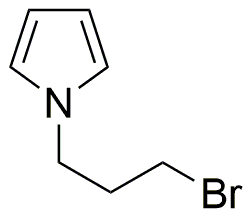1-(3-Bromopropyl)pyrrole is widely utilized in research focused on:
- Synthetic Chemistry: This compound serves as a versatile building block in the synthesis of various organic compounds, enabling chemists to create complex molecular structures efficiently.
- Pharmaceutical Development: It is explored for its potential applications in drug discovery, particularly in developing new pharmaceuticals targeting neurological disorders due to its unique chemical properties.
- Material Science: The compound is used in the formulation of advanced materials, including conductive polymers, which are essential in electronics and energy storage devices.
- Agricultural Chemistry: Researchers investigate its efficacy in developing novel agrochemicals, potentially leading to more effective pest control solutions with reduced environmental impact.
- Biochemical Research: It is utilized in studies related to biochemical pathways, helping scientists understand cellular mechanisms and interactions, which can lead to breakthroughs in various health-related fields.
Informations générales
Propriétés
Sécurité et réglementation
Applications
1-(3-Bromopropyl)pyrrole is widely utilized in research focused on:
- Synthetic Chemistry: This compound serves as a versatile building block in the synthesis of various organic compounds, enabling chemists to create complex molecular structures efficiently.
- Pharmaceutical Development: It is explored for its potential applications in drug discovery, particularly in developing new pharmaceuticals targeting neurological disorders due to its unique chemical properties.
- Material Science: The compound is used in the formulation of advanced materials, including conductive polymers, which are essential in electronics and energy storage devices.
- Agricultural Chemistry: Researchers investigate its efficacy in developing novel agrochemicals, potentially leading to more effective pest control solutions with reduced environmental impact.
- Biochemical Research: It is utilized in studies related to biochemical pathways, helping scientists understand cellular mechanisms and interactions, which can lead to breakthroughs in various health-related fields.
Documents
Fiches de données de sécurité (FDS)
La FDS fournit des informations de sécurité complètes sur la manipulation, le stockage et l’élimination du produit.
Spécifications du produit (PS)
Le PS fournit une description complète des propriétés du produit, notamment sa composition chimique, son état physique, sa pureté et les exigences de stockage. Il détaille également les plages de qualité acceptables et les applications prévues du produit.
Certificats d'analyse (COA)
Recherchez des certificats d'analyse (COA) en saisissant le numéro de lot du produit. Les numéros de lot et de lot se trouvent sur l'étiquette d'un produit, après les mots « Lot » ou « Lot de fabrication ».
Numéro de catalogue
Numéro de lot/série
Certificats d'origine (COO)
Ce certificat d'exploitation confirme le pays dans lequel le produit a été fabriqué, et détaille également les matériaux et composants utilisés et s'il est issu de sources naturelles, synthétiques ou autres sources spécifiques. Ce certificat peut être requis pour les douanes, le commerce et la conformité réglementaire.
Numéro de catalogue
Numéro de lot/série
Fiches de données de sécurité (FDS)
La FDS fournit des informations de sécurité complètes sur la manipulation, le stockage et l’élimination du produit.
DownloadSpécifications du produit (PS)
Le PS fournit une description complète des propriétés du produit, notamment sa composition chimique, son état physique, sa pureté et les exigences de stockage. Il détaille également les plages de qualité acceptables et les applications prévues du produit.
DownloadCertificats d'analyse (COA)
Recherchez des certificats d'analyse (COA) en saisissant le numéro de lot du produit. Les numéros de lot et de lot se trouvent sur l'étiquette d'un produit, après les mots « Lot » ou « Lot de fabrication ».
Numéro de catalogue
Numéro de lot/série
Certificats d'origine (COO)
Ce certificat d'exploitation confirme le pays dans lequel le produit a été fabriqué, et détaille également les matériaux et composants utilisés et s'il est issu de sources naturelles, synthétiques ou autres sources spécifiques. Ce certificat peut être requis pour les douanes, le commerce et la conformité réglementaire.


